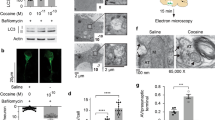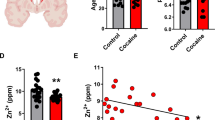Abstract
Cocaine conditioned place preference (CPP) is intact in dopamine transporter (DAT) knockout (KO) mice and enhanced in serotonin transporter (SERT) KO mice. However, cocaine CPP is eliminated in double-KO mice with no DAT and either no or one SERT gene copy. To help determine mechanisms underlying these effects, we now report examination of baselines and drug-induced changes of extracellular dopamine (DAex) and serotonin (5-HTex) levels in microdialysates from nucleus accumbens (NAc), caudate putamen (CPu), and prefrontal cortex (PFc) of wild-type, homozygous DAT- or SERT-KO and heterozygous or homozygous DAT/SERT double-KO mice, which are differentially rewarded by cocaine. Cocaine fails to increase DAex in NAc of DAT-KO mice. By contrast, systemic cocaine enhances DAex in both CPu and PFc of DAT-KO mice though local cocaine fails to affect DAex in CPu. Adding SERT to DAT deletion attenuates the cocaine-induced DAex increases found in CPu, but not those found in PFc. The selective SERT blocker fluoxetine increases DAex in CPu of DAT-KO mice, while cocaine and the selective DAT blocker GBR12909 increase 5-HTex in CPu of SERT-KO mice. These data provide evidence that (a) cocaine increases DAex in PFc independently of DAT and that (b), in the absence of SERT, CPu levels of 5-HTex can be increased by blocking DAT. Cocaine-induced alterations in CPu DA levels in DAT-, SERT-, and DAT/SERT double-KO mice appear to provide better correlations with cocaine CPP than cocaine-induced DA level alterations in NAc or PFc.
Similar content being viewed by others
Log in or create a free account to read this content
Gain free access to this article, as well as selected content from this journal and more on nature.com
or
References
Baker DA, Tran-Nguyen TL, Fuchs RA, Neisewander JL (2001). Influence of individual differences and chronic fluoxetine treatment on cocaine-seeking behavior in rats. Psychopharmacology (Berl) 155: 18–26.
Bardo MT (1998). Neuropharmacological mechanisms of drug reward: beyond dopamine in the nucleus accumbens. Crit Rev Neurobiol 12: 37–67.
Budygin EA, John CE, Mateo Y, Jones SR (2002). Lack of cocaine effect on dopamine clearance in the core and shell of the nucleus accumbens of dopamine transporter knock-out mice. J Neurosci 22: RC222.
Carboni E, Spielewoy C, Vacca C, Nosten-Bertrand M, Giros B, Di Chiara G (2001). Cocaine and amphetamine increase extracellular dopamine in the nucleus accumbens of mice lacking the dopamine transporter gene. J Neurosci 21(RC141): 141–144.
Cunningham KA, Callahan PM (1991). Monoamine reuptake inhibitors enhance the discriminative state induced by cocaine in the rat. Psychopharmacology (Berl) 104: 177–180.
Di Chiara G, Tanda GL, Frau R, Carboni E (1992). Heterologous monoamine reuptake: lack of transmitter specificity of neuron-specific carriers. Neurochem Int 20(Suppl): 231S–235S.
Eshleman AJ, Carmolli M, Cumbay M, Martens CR, Neve KA, Janowsky A (1999). Characteristics of drug interactions with recombinant biogenic amine transporters expressed in the same cell type. J Pharmacol Exp Ther 289: 877–885.
Faraj BA, Olkowski ZL, Jackson RT (1994). Active [3H]-dopamine uptake by human lymphocytes: correlates with serotonin transporter activity. Pharmacology 48: 320–327.
Franklin KBJ, Paxinos G (1997). The Mouse Brain in Stereotaxic Coordinates. Academic: San Diego.
Freed C, Revay R, Vaughan RA, Kriek E, Grant S, Uhl GR et al (1995). Dopamine transporter immunoreactivity in rat brain. J Comp Neurol 359: 340–349.
Garzon M, Pickel VM (2001). Plasmalemmal mu-opioid receptor distribution mainly in nondopaminergic neurons in the rat ventral tegmental area. Synapse 41: 311–328.
Giros B, Wang YM, Suter S, McLeskey SB, Pifl C, Caron MG (1994). Delineation of discrete domains for substrate, cocaine, and tricyclic antidepressant interactions using chimeric dopamine-norepinephrine transporters. J Biol Chem 269: 15985–15988.
Goeders NE, Dworkin SI, Smith JE (1986). Neuropharmacological assessment of cocaine self-administration into the medial prefrontal cortex. Pharmacol Biochem Behav 24: 1429–1440.
Goeders NE, Smith JE (1983). Cortical dopaminergic involvement in cocaine reinforcement. Science 221: 773–775.
Gong W, Neill D, Justice Jr JB (1996). Conditioned place preference and locomotor activation produced by injection of psychostimulants into ventral pallidum. Brain Res 707: 64–74.
Gong W, Neill D, Justice Jr JB (1997). 6-Hydroxydopamine lesion of ventral pallidum blocks acquisition of place preference conditioning to cocaine. Brain Res 754: 103–112.
Gu H, Wall SC, Rudnick G (1994). Stable expression of biogenic amine transporters reveals differences in inhibitor sensitivity, kinetics, and ion dependence. J Biol Chem 269: 7124–7130.
Hall FS, Li XF, Sora I, Xu F, Caron M, Lesch KP et al (2002). Cocaine mechanisms: enhanced cocaine, fluoxetine and nisoxetine place preferences following monoamine transporter deletions. Neuroscience 115: 153–161.
Jog MS, Kubota Y, Connolly CI, Hillegaart V, Graybiel AM (1999). Building neural representations of habits. Science 286: 1745–1749.
Kelley AE, Berridge KC (2002). The neuroscience of natural rewards: relevance to addictive drugs. J Neurosci 22: 3306–3311.
Kirkpatrick P (2001). A rewarding double act. Nature Reviews Neuroscience 3: 284.
Kleven M, Ybema C, Carilla E, Hamon M, Koek W (1995). Modification of behavioral effects of 8-hydroxy-2-(di-n-propylamino)tetralin following chronic ethanol consumption in the rat: evidence for the involvement of 5-HT1A receptors in ethanol dependence. Eur J Pharmacol 281: 219–228.
Kleven MS, Koek W (1998). Discriminative stimulus properties of cocaine: enhancement by monoamine reuptake blockers. J Pharmacol Exp Ther 284: 1015–1025.
Koob GF, Nestler EJ (1997). The neurobiology of drug addiction. J Neuropsychiatry Clin Neurosci 9: 482–497.
Kuhar MJ, Ritz MC, Boja JW (1991). The dopamine hypothesis of the reinforcing properties of cocaine. Trends Neurosci 14: 299–302.
Lee K, Kornetsky C (1998). Acute and chronic fluoxetine treatment decreases the sensitivity of rats to rewarding brain stimulation. Pharmacol Biochem Behav 60: 539–544.
Liu Y, Edwards RH (1997). The role of vesicular transport proteins in synaptic transmission and neural degeneration. Annu Rev Neurosci 20: 125–156.
Moron JA, Brockington A, Wise RA, Rocha BA, Hope BT (2002). Dopamine uptake through the norepinephrine transporter in brain regions with low levels of the dopamine transporter: evidence from knock-out mouse lines. J Neurosci 22: 389–395.
Pan Y, Gembom E, Peng W, Lesch KP, Mossner R, Simantov R (2001). Plasticity in serotonin uptake in primary neuronal cultures of serotonin transporter knockout mice. Brain Res Dev Brain Res 126: 125–129.
Parsons LH, Weiss F, Koob GF (1998). Serotonin1B receptor stimulation enhances cocaine reinforcement. J Neurosci 18: 10078–10089.
Ranaldi R, Wise RA (2001). Blockade of D1 dopamine receptors in the ventral tegmental area decreases cocaine reward: possible role for dendritically released dopamine. J Neurosci 21: 5841–5846.
Reynolds JN, Hyland BI, Wickens JR (2001). A cellular mechanism of reward-related learning. Nature 413: 67–70.
Roberts DC, Koob GF (1982). Disruption of cocaine self-administration following 6-hydroxydopamine lesions of the ventral tegmental area in rats. Pharmacol Biochem Behav 17: 901–904.
Rocha BA, Ator R, Emmett-Oglesby MW, Hen R (1997). Intravenous cocaine self-administration in mice lacking 5-HT1B receptors. Pharmacol Biochem Behav 57: 407–412.
Rocha BA, Fumagalli F, Gainetdinov RR, Jones SR, Ator R, Giros B et al (1998). Cocaine self-administration in dopamine-transporter knockout mice. Nat Neurosci 1: 132–137.
Sasaki-Adams DM, Kelley AE (2001). Serotonin-dopamine interactions in the control of conditioned reinforcement and motor behavior. Neuropsychopharmacology 25: 440–452.
Sesack SR, Hawrylak VA, Matus C, Guido MA, Levey AI (1998). Dopamine axon varicosities in the prelimbic division of the rat prefrontal cortex exhibit sparse immunoreactivity for the dopamine transporter. J Neurosci 18: 2697–2708.
Shippenberg TS, Hen R, He M (2000). Region-specific enhancement of basal extracellular and cocaine-evoked dopamine levels following constitutive deletion of the Serotonin(1B) receptor. J Neurochem 75: 258–265.
Sora I, Hall FS, Andrews AM, Itokawa M, Li XF, Wei HB et al (2001). Molecular mechanisms of cocaine reward: combined dopamine and serotonin transporter knockouts eliminate cocaine place preference. Proc Natl Acad Sci USA 98: 5300–5305.
Sora I, Wichems C, Takahashi N, Li XF, Zeng Z, Revay R et al (1998). Cocaine reward models: conditioned place preference can be established in dopamine- and in serotonin-transporter knockout mice. Proc Natl Acad Sci USA 95: 7699–7704.
Tanda G, Pontieri FE, Frau R, Di Chiara G (1997). Contribution of blockade of the noradrenaline carrier to the increase of extracellular dopamine in the rat prefrontal cortex by amphetamine and cocaine. Eur J Neurosci 9: 2077–2085.
Tzschentke TM (2001). Pharmacology and behavioral pharmacology of the mesocortical dopamine system. Prog Neurobiol 63: 241–320.
Uhl GR, Hall FS, Sora I (2002). Cocaine, reward, movement and monoamine transporters. Mol Psychiatry 7: 21–26.
Uhl GR, Li S, Takahashi N, Itokawa K, Lin Z, Hazama M et al (2000). The VMAT2 gene in mice and humans: amphetamine responses, locomotion, cardiac arrhythmias, aging, and vulnerability to dopaminergic toxins. Faseb J 14: 2459–2465.
White NM, McDonald RJ (2002). Multiple parallel memory systems in the brain of the rat. Neurobiol Learn Mem 77: 125–184.
Wise RA (1989). Opiate reward: sites and substrates. Neurosci Biobehav Rev 13: 129–133.
Yamamoto BK, Novotney S (1998). Regulation of extracellular dopamine by the norepinephrine transporter. J Neurochem 71: 274–280.
Zhou FC, Lesch KP, Murphy DL (2002). Serotonin uptake into dopamine neurons via dopamine transporters: a compensatory alternative. Brain Res 942: 109–119.
Acknowledgements
This work was supported by Grants-in-Aid from MECSST and Health Sciences Research Grants from MHLW, Japan, and NIDA-IRP, USA.
Author information
Authors and Affiliations
Corresponding author
Rights and permissions
About this article
Cite this article
Shen, Hw., Hagino, Y., Kobayashi, H. et al. Regional Differences in Extracellular Dopamine and Serotonin Assessed by In Vivo Microdialysis in Mice Lacking Dopamine and/or Serotonin Transporters. Neuropsychopharmacol 29, 1790–1799 (2004). https://doi.org/10.1038/sj.npp.1300476
Received:
Revised:
Accepted:
Published:
Issue date:
DOI: https://doi.org/10.1038/sj.npp.1300476
Keywords
This article is cited by
-
Improved green and red GRAB sensors for monitoring spatiotemporal serotonin release in vivo
Nature Methods (2024)
-
Inversed Effects of Nav1.2 Deficiency at Medial Prefrontal Cortex and Ventral Tegmental Area for Prepulse Inhibition in Acoustic Startle Response
Molecular Neurobiology (2024)
-
Behavioral phenotype, intestinal microbiome, and brain neuronal activity of male serotonin transporter knockout mice
Molecular Brain (2023)
-
Normalizing hyperactivity of the Gunn rat with bilirubin-induced neurological disorders via ketanserin
Pediatric Research (2022)
-
Enhanced discriminative aversive learning and amygdala responsivity in 5-HT transporter mutant mice
Translational Psychiatry (2019)



